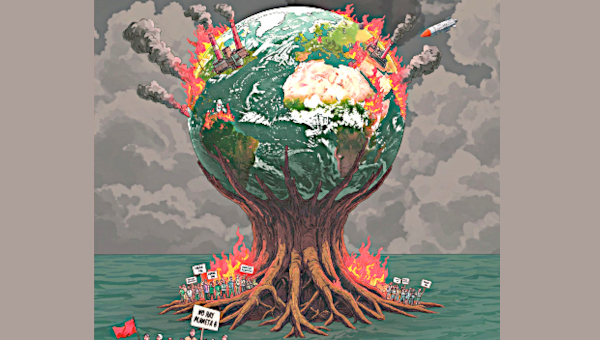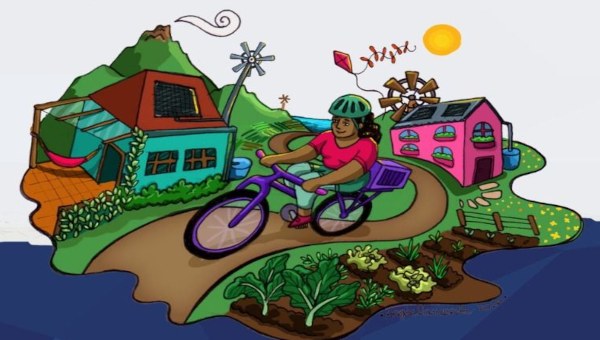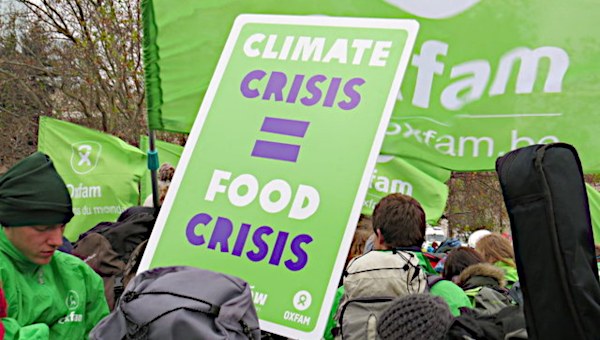Food Crisis II – Capitalism, Agribusiness, and the Food Sovereignty Alternative
When food riots broke out in Haiti last month, the first country to respond was Venezuela. Within days, planes were on their way from Caracas, carrying 364 tons of badly needed food.
The people of Haiti are “suffering from the attacks of the empire’s global capitalism,” Venezuelan president Hugo Chàvez said. “This calls for genuine and profound solidarity from all of us. It is the least we can do for Haiti.”
Venezuela’s action is in the finest tradition of human solidarity. When people are hungry, we should do our best to feed them. Venezuela’s example should be applauded and emulated.
But aid, however necessary, is only a stopgap. To truly address the problem of world hunger, we must understand and then change the system that causes it.
No shortage of food
The starting point for our analysis must be this: there is no shortage of food in the world today.
Contrary to the 18th century warnings of Thomas Malthus and his modern followers, study after study shows that global food production has consistently outstripped population growth, and that there is more than enough food to feed everyone. According to the United Nations Food and Agriculture Organization, enough food is produced in the world to provide over 2800 calories a day to everyone – substantially more than the minimum required for good health. That’s about 18% more calories per person than in the 1960s, despite a significant increase in total population.[1]
As the Food First Institute points out, “abundance, not scarcity, best describes the supply of food in the world today.”[2]
Despite that, the most commonly proposed solution to world hunger is new technology to increase food production.
The Alliance for a Green Revolution in Africa, funded by the Bill and Melinda Gates Foundation and the Rockefeller Foundation, aims to develop “more productive and resilient varieties of Africa’s major food crops” to enable Africa’s small-scale farmers to produce larger, more diverse and reliable harvests.”[3]
Similarly, the Manila-based International Rice Research Institute has initiated a public-private partnership “to increase rice production across Asia via the accelerated development and introduction of hybrid rice technologies.”[4]
And the president of the World Bank promises to help developing countries gain “access to technology and science to boost yields.”[5]
Scientific research is vitally important to the development of agriculture, but initiatives that assume in advance that new seeds and chemicals are needed are neither credible nor truly scientific. The fact that there is already enough food to feed the world shows that the food crisis is not a technical problem – it is a social and political problem.
Rather than asking how to increase production, our first question should be why, when so much food is available, are over 850 million people hungry and malnourished? Why do 18,000 children die of hunger every day?
Why can’t the global food industry feed the hungry?
The profit system
The answer can be stated in one sentence. The global food industry is not organized to feed the hungry; it is organized to generate profits for corporate agribusiness.
The agribusiness giants are achieving that objective very well indeed. This year, agribusiness profits are soaring above last year’s levels, while hungry people from Haiti to Egypt to Senegal were taking to the streets to protest rising food prices. These figures are for just three months at the beginning of 2008.[6]
Grain Trading
- Archer Daniels Midland (ADM). Gross profit: $1.15 billion, up 55% from last year
- Cargill: Net earnings: $1.03 billion, up 86%
- Bunge. Consolidated gross profit: $867 million, up 189%.
Seeds & herbicides
- Monsanto. Gross profit: $2.23 billion, up 54%.
- Dupont Agriculture and Nutrition. Pre-tax operating income: $786 million, up 21%
Fertilizer
- Potash Corporation. Net income: $66 million, up 185.9%
- Mosaic. Net earnings: $520.8 million, up more than 1,200%
The companies listed above, plus a few more, are the monopoly or near-monopoly buyers and sellers of agricultural products around the world. Six companies control 85% of the world trade in grain; three control 83% of cocoa; three control 80% of the banana trade.[7] ADM, Cargill and Bunge effectively control the world’s corn, which means that they alone decide how much of each year’s crop goes to make ethanol, sweeteners, animal feed or human food.
As the editors of Hungry for Profit write, “The enormous power exerted by the largest agribusiness/food corporations allows them essentially to control the cost of their raw materials purchased from farmers while at the same time keeping prices of food to the general public at high enough levels to ensure large profits.”[8]
Over the past three decades, transnational agribusiness companies have engineered a massive restructuring of global agriculture. Directly through their own market power and indirectly through governments and the World Bank, IMF and World Trade Organization, they have changed the way food is grown and distributed around the world. The changes have had wonderful effects on their profits, while simultaneously making global hunger worse and food crises inevitable.
The assault on traditional farming
Today’s food crisis doesn’t stand alone: it is a manifestation of a farm crisis that has been building for decades.
Over the past three decades the rich countries of the north have forced poor countries to open their markets, then flooded those markets with subsidized food, with devastating results for Third World farming.
But the restructuring of global agriculture to the advantage of agribusiness giants didn’t stop there. In the same period, southern countries were convinced, cajoled and bullied into adopting agricultural policies that promote export crops rather than food for domestic consumption, and favour large-scale industrial agriculture that requires single-crop (monoculture) production, heavy use of water, and massive quantities of fertilizer and pesticides. Increasingly, traditional farming, organized by and for communities and families, has been pushed aside by industrial farming organized by and for agribusinesses.
That transformation is the principal obstacle to a rational agriculture that could eliminate hunger.
The focus on export agriculture has produced the absurd and tragic result that millions of people are starving in countries that export food. In India, for example, over one-fifth of the population is chronically hungry and 48% of children under five years old are malnourished. Nevertheless, India exported US$1.5 billion worth of milled rice and $322 million worth of wheat in 2004.[9]
In other countries, farmland that used to grow food for domestic consumption now grows luxuries for the north. Colombia, where 13% of the population is malnourished, produces and exports 62% of all cut flowers sold in the United States.
In many cases the result of switching to export crops has produced results that would be laughable if they weren’t so damaging. Kenya was self-sufficient in food until about 25 years ago. Today it imports 80% of its food – and 80% of its exports are other agricultural products.[10]
The shift to industrial agriculture has driven millions of people off the land and into unemployment and poverty in the immense slums that now surround many of the world’s cities.
The people who best know the land are being separated from it; their farms enclosed into gigantic outdoor factories that produce only for export. Hundreds of millions of people now must depend on food that’s grown thousands of miles away because their homeland agriculture has been transformed to meet the needs of agribusiness corporations. As recent months have shown, the entire system is fragile: India’s decision to rebuild its rice stocks made food unaffordable for millions half a world away.
If the purpose of agriculture is to feed people, the changes to global agriculture in the past 30 years make no sense. Industrial farming in the Third World has produced increasing amounts of food, but at the cost of driving millions off the land and into lives of chronic hunger – and at the cost of poisoning air and water, and steadily decreasing the ability of the soil to deliver the food we need.
Contrary to the claims of agribusiness, the latest agricultural research, including more than a decade of concrete experience in Cuba, proves that small and mid-sized farms using sustainable agroecological methods are much more productive and vastly less damaging to the environment than huge industrial farms.[11]
Industrial farming continues not because it is more productive, but because it has been able, until now, to deliver uniform products in predictable quantities, bred specifically to resist damage during shipment to distant markets. That’s where the profit is, and profit is what counts, no matter what the effect may be on earth, air, and water – or even on hungry people.
Fighting for food sovereignty
The changes imposed by transnational agribusiness and its agencies have not gone unchallenged. One of the most important developments in the past 15 years has been the emergence of La Vía Campesina (Peasant Way), an umbrella body that encompasses more than 120 small farmers’ and peasants’ organizations in 56 countries, ranging from the Landless Rural Workers Movement (MST) in Brazil to the National Farmers Union in Canada.
La Vía Campesina initially advanced its program as a challenge to the “World Food Summit,” a 1996 UN-organized conference on global hunger that was attended by official representatives of 185 countries. The participants in that meeting promised (and subsequently did nothing to achieve) the elimination of hunger and malnutrition by guaranteeing “sustainable food security for all people.”[12]
As is typical of such events, the working people who are actually affected were excluded from the discussions. Outside the doors, La Vía Campesina proposed food sovereignty as an alternative to food security. Simple access to food is not enough, they argued: what’s needed is access to land, water, and resources, and the people affected must have the right to know and to decide about food policies.
Food is too important to be left to the global market and the manipulations of agribusiness: world hunger can only be ended by re-establishing small and mid-sized family farms as the key elements of food production.[13]
The central demand of the food sovereignty movement is that food should be treated primarily as a source of nutrition for the communities and countries where it is grown. In opposition to free-trade, agroexport policies, it urges a focus on domestic consumption and food self-sufficiency.
Contrary to the assertions of some critics, food sovereignty is not a call for economic isolationism or a return to an idealized rural past. Rather, it is a program for the defense and extension of human rights, for land reform, and for protection of the earth against capitalist ecocide. In addition to calling for food self-sufficiency and strengthening family farms, La Vía Campesina’s original call for food sovereignty included these points:
- Guarantee everyone access to safe, nutritious and culturally appropriate food in sufficient quantity and quality to sustain a healthy life with full human dignity.
- Give landless and farming people – especially women – ownership and control of the land they work and return territories to indigenous peoples.
- Ensure the care and use of natural resources, especially land, water and seeds. End dependence on chemical inputs, on cash-crop monocultures and intensive, industrialized production.
- Oppose WTO, World Bank and IMF policies that facilitate the control of multinational corporations over agriculture. Regulate and tax speculative capital and enforce a strict Code of Conduct on transnational corporations.
- End the use of food as a weapon. Stop the displacement, forced urbanization and repression of peasants.
- Guarantee peasants and small farmers, and rural women in particular, direct input into formulating agricultural policies at all levels.[14]
La Vía Campesina’s demand for food sovereignty constitutes a powerful agrarian program for the 21st century. Labour and left movements worldwide should give full support to it and to the campaigns of working farmers and peasants for land reform and against the industrialization and globalization of food and farming.
Stop the war on Third World farmers
Within that framework, we in the global north can and must demand that our governments stop all activities that weaken or damage Third World farming.
Stop using food for fuel. La Vía Campesina has said it simply and clearly: “Industrial agrofuels are an economic, social and environmental nonsense. Their development should be halted and agricultural production should focus on food as a priority.”[15]
Cancel Third World debts. On April 30, Canada announced a special contribution of C$10 million for food relief to Haiti.[16] That’s positive, but during 2008 Haiti will pay five times that much in interest on its $1.5-billion foreign debt, much of which was incurred during the imperialist-supported Duvalier dictatorships.
Haiti’s situation is not unique and it is not an extreme case. The total external debt of Third World countries in 2005 was $2.7-trillion, and their debt payments that year totalled $513-billion.[17] Ending that cash drain, immediately and unconditionally, would provide essential resources to feed the hungry now and rebuild domestic farming over time.
Get the WTO out of agriculture. The regressive food policies that have been imposed on poor countries by the World Bank and IMF are codified and enforced by the World Trade Organization’s Agreement on Agriculture. The AoA, as Afsar Jafri of Focus on the Global South writes, is “biased in favour of capital-intensive, corporate agribusiness-driven and export-oriented agriculture.”[18] That’s not surprising, since the U.S. official who drafted and then negotiated it was a former vice-president of agribusiness giant Cargill.
AoA should be abolished, and Third World countries should have the right to unilaterally cancel liberalization policies imposed through the World Bank, IMF, and WTO, as well as through bilateral free trade agreements such as NAFTA and CAFTA.
Self-Determination for the Global South. The current attempts by the U.S. to destabilize and overthrow the anti-imperialist governments of the ALBA group – Venezuela, Bolivia, Cuba, Nicaragua and Grenada – continue a long history of actions by northern countries to prevent Third World countries from asserting control over their own destinies. Organizing against such interventions “in the belly of the monster” is thus a key component of the fight to win food sovereignty around the world.
* * *
More than a century ago, Karl Marx wrote that despite its support for technical improvements, “the capitalist system works against a rational agriculture – a rational agriculture is incompatible with the capitalist system.”[19]
Today’s food and farm crises completely confirm that judgment. A system that puts profit ahead of human needs has driven millions of producers off the land, undermined the earth’s productivity while poisoning its air and water, and condemned nearly a billion people to chronic hunger and malnutrition.
The food crisis and farm crisis are rooted in an irrational, anti-human system. To feed the world, urban and rural working people must join hands to sweep that system away. •
Endnotes
1.
Frederic Mousseau, Food Aid or
Food Sovereignty? Ending World Hunger in Our Time. Oakland Institute, 2005.
International Assessment of Agricultural Knowledge, Science and Technology for Development,
Global Summary for Decision Makers.
2.
Francis Moore Lappe, Joseph Collins, Peter Rosset. World Hunger: Twelve Myths. (Grove Press, New York, 1998) p. 8
3.
“About the Alliance for a Green Revolution in Africa.”
4.
IRRI Press Release, April 4, 2008.
5.
“World Bank President Calls for Plan to Fight Hunger in Pre-Spring Meetings Address.” News Release, April 2, 2008.
6.
These figures are taken from the companies’ most recent quarterly reports, found on their websites. Because they report the numbers in different ways, they can’t be compared to each other, only to their own previous reports.
7.
Shawn Hattingh. “Liberalizing Food Trade to Death.” MRzine, May 6, 2008.
8.
Fred Magdoff, John Bellamy Foster and Frederick H. Buttel.
Hungry for Profit: The Agribusiness Threat to Farmers, Food, and the Environment.
Monthly Review Press, New York, 2000. p. 11
9.
UN Food and Agriculture Organization.
Key Statistics Of Food And Agriculture External Trade.
10.
J. Madeley. Hungry for Trade: How the poor pay for free trade. Cited in Ibid.
11.
Jahi Campbell, “Shattering Myths: Can sustainable agriculture feed the world?” and “Editorial.
Lessons from the Green Revolution.” Food First Institute. www.foodfirst.org.
13.
La Vía Campesina. “Food Sovereignty: A Future Without Hunger.” (1996)
14.
Paraphrased from Ibid.
15.
La Vía Campesina.
“A response to the Global Food Prices Crisis: Sustainable family farming can feed the world.”
16.
By way of comparison, this year Canada will spend $1 billion on the illegal occupation of and war in Afghanistan.
17.
Jubilee Debt Campaign. “The Basics About Debt.”
18.
Afsar H. Jafri. “WTO: Agriculture at the Mercy of Rich Nations.” Focus on the Global South, November 7, 2005.
19.
Capital, Volume III. Karl Marx & Frederick Engels, Collected Works, Volume 37, p. 123





